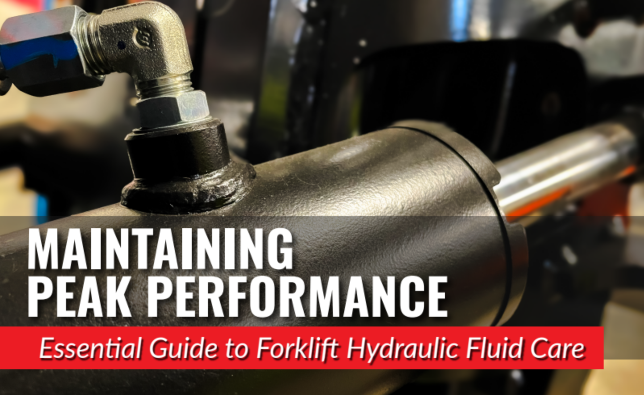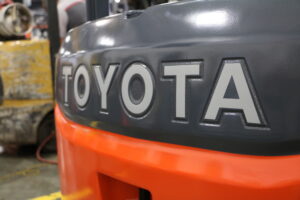Are you interested in improving the performance of your forklift by maintaining its hydraulic system? Well, you are in the right place!
Welcome to your comprehensive guide on forklift hydraulic fluid – the vital component that keeps your machine running smoothly. We will delve into everything you need to know about forklift hydraulic fluid, from its importance to maintenance procedures and common issues you may encounter.
Here is what you will discover:
- The significance of forklift hydraulic fluid
- Maintenance procedures to ensure peak performance
- Common issues and solutions
- Manufacturer recommendations for fluid selection
- And much more!
Whether you are a seasoned forklift operator or new to the industry, this guide will give you the knowledge you need to manage your forklift’s hydraulic system.
Let’s dive in!
Forklift Hydraulic Fluid
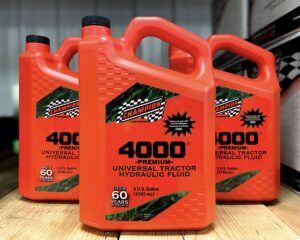
Forklift hydraulic oil (also known as hydraulic fluid) is a crucial component of your machine. Without it, your forklift will not be able to operate, as nothing moves without it.
One common thing every machine operating on the planet has is they all require hydraulic fluid. Yes, the hydraulic fluid for the telehandler, forklift, and pallet jacket.
For machines to function effectively, they need hydraulic fluid. The fluid enables forklift hydraulic systems to steer and lift objects swiftly. It also makes it possible for machines to lift and move weighty cargo.
Part of forklift ownership is changing your fluid regularly.
Continue reading to learn more about forklift hydraulic fluid, including regular servicing and fluid replacement for optimal performance.
Importance of Regular Maintenance and Servicing
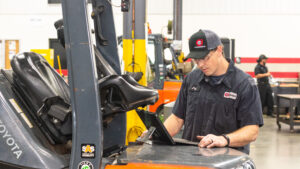
Forklift Operation
Forklifts are usually used in industrial complexes and manufacturing plants to lift and move heavy loads over short distances and maneuver tight spaces.
Regular maintenance helps identify and address problems such as worn-out brakes, faulty steering, or malfunctioning features.
Imagine the risk of operating a forklift with worn-out brakes. If the brakes fail during operation, it may cause collisions, property damage, or harm to individuals.
Keeping forklift parts in better condition can improve productivity, reduce downtime, and handle heavier loads more efficiently to ensure the forklift operates at its peak.
If you want to guarantee the safety of both operators and those working around forklifts, your forklift needs regular maintenance. Forklifts are complex machines that need all components to work together to maintain safe operation.
Routine Servicing
Routine servicing involves inspecting and adjusting key components such as the engine, transmission, hydraulic system, and tires to ensure smooth and safe forklift operation.
Servicing your forklift is a crucial step in keeping safety and preventing accidents in the workplace. It allows technicians to inspect features such as brakes, lights, horns, and seat belts.
If any signs of wear and tear are detected, take necessary actions to ensure the forklift complies with safety regulations. For instance, if the brakes show wear, they need to be replaced promptly to minimize the risk of accidents and injuries resulting from brake failure.
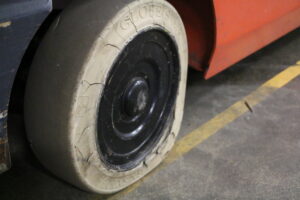
Service Guidelines
When servicing your forklift, follow these guidelines:
- Tires: Are there any signs of damage or deformation? If your tires are damaged, replace them as soon as possible. Ensure the tire pressure is correct and inflated according to the recommended pressure set by the manufacturer.
- Fluid levels: Check and maintain the fluid levels of components like engine oil, coolant, hydraulic fluid, and brake fluid.
- Battery maintenance: If the forklift is electric-powered, follow the specified instructions for your battery maintenance. It may include regular inspections of battery cables, connections, and electrolyte levels. Properly charge the battery based on the recommended procedures and avoid overcharging or deep discharging.
- The brakes: Check if the handbrake and brake pedal are functioning. If not, make adjustments as needed. Refer to the service manual of your forklift machine for instructions on adjusting the brakes. Is the brake fluid level below the ‘LOW’ mark? It could indicate worn brakes or a leak in the brake system.
- The chassis: Inspect all nuts and bolts on the chassis and tighten any loose. Lubricate all the necessary points, such as the steering wheel and the lubrication nipples. Before proceeding to the next check, ensure the gear lever is neutral and engage the handbrake.
Hydraulic System Components and Technology
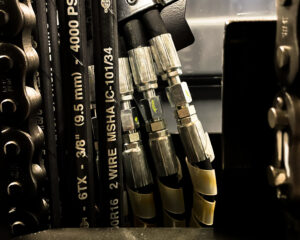
Hydraulic systems provide machines with the strength required to perform their tasks. While using fluid power, forklifts can easily lift and lower heavy boxes, pallets, and other cargo.
Understanding the components and technology behind hydraulic systems is fundamental for operators and maintenance personnel.
Hydraulic systems rely on hydraulic pumps, usually powered by forklift engines or electric motors. These pumps pressurize hydraulic fluid, creating the force required for lifting operations.
The system directs the pressurized fluid to hydraulic cylinders, which raise and lower the forks. These cylinders consist of a piston and a cylinder barrel with seals to prevent fluid leakage. By controlling the flow of forklift hydraulic fluid into and out of the cylinders, the operator can accurately control the height and movement of the forks.
Control valves are another component of the hydraulic system responsible for controlling the flow of hydraulic fluid. Valves determine the direction of fluid flow— enabling the operators to control the movement of the forks and other hydraulic functions.
Energy Transmission
Energy transmission is the ability to convert and transmit mechanical energy into hydraulic pressure, which powers the lifting and maneuvering functions of the forklift.
The energy transmission begins with the forklift engine or motor, which provides the mechanical energy required for operation. This mechanical energy drives the hydraulic pump that pressurizes the forklift hydraulic fluid. The pump draws the hydraulic fluid from the reservoir and exerts a force on it, increasing its pressure.
Once pressurized, the hydraulic fluid carries energy within the system. It flows through a network of hoses and fittings, guided by control valves— towards the hydraulic cylinders.

When the operator activates the lifting or lowering controls, the control valves regulate the flow of hydraulic fluid into and out of the hydraulic cylinders. This controlled flow causes the pistons to move, allowing the fork mechanism to raise or lower as desired.
The hydraulic pressure is then transmitted to the cylinders, converting the energy from the hydraulic fluid into the lifting or lowering force needed to handle loads.
Thermal Expansion
In addition to transmitting energy, thermal expansion happens when a substance, like forklift hydraulic fluid, changes volume in response to temperature changes. When the temperature fluctuates, the hydraulic fluid expands or contracts accordingly.
When the hydraulic fluid heats up, its molecules gain more kinetic energy and start moving vigorously, spreading them out. This increased molecular movement leads to an expansion of the fluid, thus increasing its volume.
Hydraulic systems components accommodate the volume changes in the hydraulic fluid through their design. One method is to integrate expansion reservoirs or compensators. These reservoirs provide additional space for the expanded fluid. Consequently, this allows it to expand without causing excessive buildup pressure in the system.
Fluid Maintenance Procedures
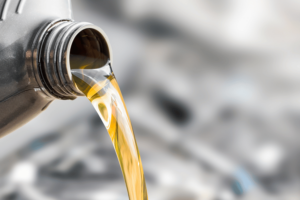
Fluid Level Inspection
Maintaining the required fluid levels can prevent damage and promote better performance by ensuring the system generates adequate pressure and lubrication.
To maintain proper fluid levels, follow these procedures:
- Follow manufacturer guidelines: Every forklift model has specific guidelines provided by the manufacturer. These guidelines include the recommended fluid level range and additional instructions for checking and maintaining the fluid level.
- Inspect the fluid level when cold: Hydraulic fluid expands when heated, which affects the fluid level. For the most accurate reading on the hydraulic fluid, it is best to check the fluid level when the hydraulic system is cold because this ensures that the fluid is at its usual operating level.
- Use the correct dipstick or indicator: Forklifts may have different fluid level indicators, such as dipsticks or sight gauges. Be familiar with the specific indicator used in your forklift and ensure it is clean and debris-free before checking the fluid level.
- Top-up fluid properly: If the fluid level is below the given range, add the hydraulic fluid as specified in the forklift manual. Use a clean funnel to avoid introducing contaminants into the system. Add fluid gradually, allowing it to settle before rechecking the level.
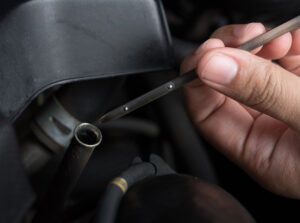
Using a dipstick to monitor oil
Oil Level Inspection
Monitoring oil levels can prevent damage and extend the longevity of forklift hydraulic systems. When monitoring oil levels, follow these steps:
- Safety precautions: Before starting any maintenance procedure, prioritize safety. Ensure the forklift is on a stable surface, engage the handbrake, and turn off the engine.
- Locate oil reservoir: Identify the hydraulic oil reservoir in the forklift. It is usually a large, cylindrical tank near the engine or hydraulic pump.
- Check oil level indicator: Forklifts may have various oil level indicators, such as dipsticks, sight glasses, or electronic sensors. Refer to the forklift manual to determine the type of indicator to use.
- Clean indicator: If using a dipstick or sight glass, clean it thoroughly to remove dirt to ensure accurate reading.
- Check oil level: Insert the dipstick into the oil reservoir or observe the oil level through the sight glass. Take note of the oil level with the markings on the indicator. The markings indicate “Full” and “Low.”
- Add oil: Examine the oil levels. If they are below the “Low” marker, add hydraulic fluid. Check the forklift manual for the correct type of hydraulic fluid. Use a clean funnel to avoid contamination, and add the fluid slowly, periodically rechecking the level until it reaches the appropriate range.
- Avoid overfilling: Do not overfill the hydraulic fluid reservoir. Excessive fluid can cause increased pressure and system issues. Ensure the fluid remains within the required range.
- Inspect leaks: While monitoring the oil level, take the time to inspect the hydraulic system for any signs of oil leaks. Look for visible oil stains or puddles beneath the forklift. If a leak is detected, it should be addressed quickly by a qualified technician.
- Document maintenance: Maintain a record of oil level checks and any maintenance actions taken to help identify patterns in fluid maintenance.
Fluid Replacement
After monitoring oil levels, it is time to consider replacement. According to most forklift manufacturers, You should replace hydraulic fluid after every 1,000 hours of operation. Operators should review a checklist before each shift to properly monitor oil levels.
Before starting the hydraulic fluid replacement process on a forklift, it is crucial to ensure that the new fluid added matches the existing fluid in the machine.
Forklift hydraulic fluids come in various types, including oil-based, water-based, and synthetic, each with its viscosity grades.
The choice of hydraulic fluid depends on factors like the type of forklift, the specific equipment model, manufacturer recommendations, operating conditions, and the type of fluid used. For instance, synthetic fluid helps regulate temperature in hot and cold environments.
Therefore, it is always wiser to match the hydraulic fluid when changing it because, after even draining the fluid, some of the original fluid may remain in the tank.
Steps to Change Hydraulic Fluid
Once you are confident that the hydraulic fluid you have added matches the one in the tank, you may proceed to the next steps in the process:
- Apply the parking brake and park in a flat area.
- Ensure that the forklift carriage is complete.
- Put off the ignition.
- Locate the plug near the base of the hydraulic fluid tank.
- Ensure that a container is under this plug. Check the operating manual to find out the capacity of the container.
- After removing the plug, have a moment to think about the soothing sound and sight of the draining liquid.
- Scan carefully for any dirt, buildup, or debris. Take a look inside the tank. If necessary, clean it.
- Return the plug in the tank.
- Double-check to make sure that the plug is inside the tank.
- Take off the cap located on the top of the hydraulic fluid tank.
- Pour the hydraulic fluid into the tank to monitor the gauge closely as you fill it. Slow down as the fluid approaches the fill line, and stop filling once the tank is full. Be careful to fill the tank sparingly.
- If there is any hydraulic fluid spillage, clean it up immediately.
- Replace the cap.
Fluid Compatibility and Safety
Essentially, hydraulic fluid matching and compatibility are about finding a fluid that will not cause any issues or damage to the system.
It is the process of selecting the hydraulic fluid that aligns with what the manufacturer suggests and meets the specific needs of the hydraulic system.
The process includes considering factors like the type of fluid, its viscosity grade, compatibility with additives, and the seal compatibility used in the system.
As discussed earlier, forklifts use hydraulic fluids that are mineral oil-based, synthetic, or water-based. The type of fluid you use should align with what the manufacturer recommends and meet the needs of the hydraulic system.
Hydraulic fluids have different viscosity grades, which determine their flow characteristics. Choosing the correct grade helps in maintaining proper lubrication and hydraulic system performance.
Sometimes, hydraulic fluids can have extra ingredients like additives that enhance properties like reducing wear, preventing foaming, or protecting against corrosion. Select hydraulic fluid that is compatible with the additives already in your system.
Safety Precautions
To keep safe while handling forklift hydraulic fluid, follow these precautions to protect yourself and maintain a safe work atmosphere.

- i) Protective gear: Always wear personal protective equipment (PPE). These include gloves, safety goggles, and protective clothing. These items protect your skin and eyes from possible contact with the fluid.
- ii) Handling techniques: Use proper lifting techniques when moving containers to avoid injuries. Avoid sudden movements or jerks that could cause spills or leaks. Utilize tools like funnels or pumps to pour and transfer the fluid with control.
- iii) Ventilation: Ensure proper airflow in the space when handling hydraulic fluid. Good ventilation helps disperse any fumes or vapors that may be present. Consider using fans or opening windows when working in an enclosed space to improve air circulation.
- iv) Storage: Store hydraulic fluid in a designated area that is correctly labeled. Make sure to seal the containers to avoid contamination and spills. Keep them away from heat sources or anything that could ignite the fluid to reduce the risk of fire or explosions.
- v) Contamination prevention: Maintain cleanliness in your working area and equipment. Use clean tools and containers to avoid dirt, water, or other contaminants while handling the fluid.
- vi) Spill response: If a spill occurs, act immediately to reduce the risk of slips, falls, or environmental contamination. Use absorbent materials like spill kits or pads to contain and clean up the spill.
Impact on Forklift Functionality
Low levels of oil or degradation of fluid in a forklift hydraulic system can contribute to issues such as:
- Reduced lifting capacity
- Sluggish operation
- Increased wear and tear
- Overheating
- Impaired control and responsiveness
If there are issues with the hydraulic fluid in a forklift, it can mess with how well it lifts and steers. Contamination, whether from dirt, debris, or water, can clog up filters, valves, and other parts— interfering with the ability of the fluid to push pressure and operate the hydraulic system as it should.
Over time, the fluid can degrade, losing its thickness (viscosity), which results in reduced lubrication and decreased performance.
Hydraulic fluid leaks can occur in the hydraulic system, leading to a decrease in fluid levels. Low fluid levels can cause inadequate pressure, impacting the lifting capacity and responsiveness of the forklift.
Forklifts are specialized vehicles with lifting mechanisms, usually forks or attachments, specifically designed to lift, move, and stack materials.
The ability to handle and move heavy loads in industrial environments lies in the functionality of a forklift. The main functions of a forklift include:
- Lifting and Lowering: Forklifts lift and lower materials to specific heights using a hydraulic system for power.
- Load Handling: Forklifts can carry and transport heavy loads over short distances, making them essential for loading and unloading goods in warehouses and manufacturing facilities.
- Steering and Maneuverability: Forklifts have steering systems that enable operators to navigate tight aisles and cramped spaces. The capability to maneuver accurately is essential for effective material handling.
- Hydraulic System: The hydraulic system utilizes hydraulic fluid, pumps, and cylinders to transmit force, allowing for controlled and efficient movement of the lifting mechanism.
Impact of Low Oil Levels
Every forklift uses hydraulic oil and cylinders to operate. If a hydraulic cylinder is not functioning effectively, the issue might be due to low hydraulic oil.
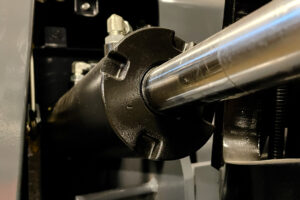
The cylinders are responsible for controlling the movement of the lift. However, failure to properly maintain hydraulic oil levels can have an impact on your machine, including:
-
- Overheating: If the hydraulic system becomes excessively hot, it can lead to the forklift being unable to function well. The heat causes the hydraulic fluids to thin out, which reduces lubrication and increases the likelihood of leaks. When the fluid temperature rises above 180°F, it adversely affects the hydraulic system.
- Slow movement: Leaking hoses can lead to sluggish movement. Hoses can deteriorate over time or fill with an incompatible fluid. These hoses are mandated to carry hydraulic fluids. So, if there are any signs of leaks or damages, these can negatively affect the ability to perform better.
- Lift failures: Lift failures are a common problem with forklifts, often caused by insufficient hydraulic oil levels due to leaks. Any indications of oil leakage can potentially result in lift failure.
Signs and Solutions

Determining the exact timing for an oil change in a forklift may not have a universally applicable rule. However, various signs can indicate when it is time for an oil change.
Signs for Oil Change
These indicators may vary based on the specific forklift model and manufacturer requirements. Here are some common signs to pay attention to:
- a) Discolored or dirty oil: Once you notice the oil in the forklift appears dark, murky, or has visible contaminants, it is a clear sign that an oil change is necessary.
- b) Unusual engine noise: When the engine starts making unusual noises such as knocking, rattling, or grinding sounds, this could indicate inadequate lubrication due to degraded oil.
- c) Increased fuel consumption: If you observe a sudden rise in fuel consumption without a clear explanation, it might indicate the need for an oil change.
Importance of Hydraulic Oil
Hydraulic fluid provides lubrication to the hydraulic moving parts. It reduces friction between components and prevents excessive wear and tear. By forming a protective film on surfaces that come into contact with each other, hydraulic oil can lower frictional heat generation and help extend the lifespan of hydraulic system components.
As the hydraulic system operates, it generates heat due to energy transfer and mechanical processes. The hydraulic oil absorbs and carries away this heat, preventing overheating of the components.
Another advantage of hydraulic oil is the removal of contaminants from the hydraulic system. Over time, dirt, debris, and metal particles can enter the system and cause damage. Hydraulic oil is a cleaning agent, trapping and carrying away these contaminants.
The hydraulic oil passes through filters and other components designed to remove impurities, ensuring the cleanliness of the hydraulic system and preventing damage to sensitive parts.
Solutions to Hydraulic Fluid-Related Issues
To navigate swiftly and help you address common forklift problems, consider implementing the following measures:
- Check and maintain oil levels: Regularly monitor the hydraulic oil levels in the forklift. Ensure that the oil is at the recommended level specified by the manufacturer. If the oil level is low, add the oil to bring it back to the required level.
- Change the oil: If the hydraulic oil appears dirty, contaminated, or has exceeded its recommended service life, drain and replace it with fresh oil. Be sure to adhere to the guidelines regarding the type of hydraulic oil to use and follow the recommended oil change intervals.
- Clean or replace filters: Hydraulic systems have filters that remove contaminants from the oil. Clean or replace these filters to ensure proper filtration and clogging prevention.
- Perform regular maintenance: Follow the scheduled maintenance plan for the hydraulic system. This procedure involves regularly inspecting and maintaining hydraulic hoses, seals, fittings, and other components. Routine maintenance is crucial as it helps detect potential issues early and prevent major problems from arising.
- Use proper oil: Ensure that the appropriate type and grade of hydraulic oil matches the specific forklift model. Using the wrong oil can result in performance issues or damage to the hydraulic system.
Common Issues and Solutions
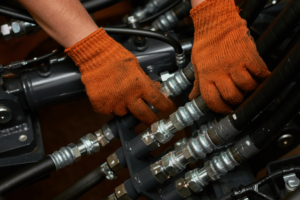
As technology advances, automotive engines become more advanced, faster, and more efficient.
However, these advancements also come with their challenges. The degradation of oil is the most notable issue.
What is clear is that you do not understand why your oil is degrading in the first place. Oil degradation is due to factors such as;
1. Oxidization
This issue involves the reaction of materials with oxygen. When oxidation occurs, it can lead to problems such as:
-
- The fluid viscosity tends to increase, making it thicker and less effective.
- Particles accumulate in the fluid, potentially causing clogs and reducing performance.
- The additives in the fluid can deplete over time, further diminishing its effectiveness.
As a result, the oil begins to break down, and the components that depend on the oil may start to experience rust and corrosion.
2. Thermal Breakdown
The temperature at which the hydraulic oil operates can cause degradation. When the temperature rises too high, the oil viscosity oil can decrease to a point where it starts to break down.
On the flip side, if the temperature rapidly decreases, the oil’s viscosity can increase, causing it to become thicker and less efficient.
3. Particulate Contamination
Solid or water contamination accounts for over 80% of hydraulic failures. The oil degradation of a forklift depends on the type and volume of contamination. Water, bacterial ingress, silica, and certain metals can cause your oil to degrade.
Carefully maintaining the hydraulic system can smoothen operation and prolong the lifespan of the forklift. Here are some tasks you can take to maintain the hydraulic system:
- Replace the hydraulic oil in the tank every 4,000 hours of operation
- After every 2,000 hours, ensure to change the hydraulic filter
- Regularly inspect the cylinders for any signs of air or fluid leaks
- Keep an eye on the hydraulic pump for any signs of premature wear and tear
- Examine the seals for any signs of rotting or cracking
- Ensure the forks and chains are in good condition and functioning safely
Changing Hydraulic Fluid
Most manufacturers recommend changing the hydraulic oil roughly after every 1,000 hours of operation. It is crucial to check the fluid levels before proceeding with the oil change.
- To check and change your fluid levels, identify the oil reservoir in the hydraulic system of your forklift. Safely park the forklift on a level surface and engage the parking brake. Turn off the engine and allow sufficient time for the system to cool down.
- Remove the cap or dipstick from the oil reservoir. Wipe the dipstick clean with a cloth or paper towel. Insert the dipstick back into the reservoir and then remove it again. Observe the oil level on the dipstick. There should be indicators on the dipstick to show the optimal oil level.
- If the oil level falls below the specified range, add oil. Once the oil level is adjusted, replace the reservoir cap or dipstick to ensure a tight seal to prevent leaks.
- Finally, to check that the slow movement issue has been resolved by starting the engine and operating the forklift.
If you have and questions or concerns about changing your forklift hydraulic fluid, contact a local forklift service company such as Conger for assistance.
Leak Detection and Repair
Forklifts depend on fluid systems like hydraulics, cooling, and steering systems. When aspects of these systems experience wear and tear, leaks are likely to occur.
Oil leaks can pose risks like fires and operational delays and expose workers to harmful chemicals.
Leaks can occur due to a cracked cylinder. The hydraulic system of a forklift has different types of cylinders, including tilt and lift cylinders. Over time, the high pressure within the system can cause wear and tear on these cylinders, leading to cracks and leakage.
Taking a proactive approach to forklift maintenance can prevent leaks from occurring.
Examine the hoses for signs of wear and tear to spot potential weak points where leaks could occur. Also, look out for loose fittings and clamps and fix them promptly to prevent them from becoming problematic.
By staying vigilant and addressing problems as early as possible, you can effectively prevent leaks and maintain the performance of your forklift.
Manufacturer Recommendations
Forklift manufacturers provide clear instructions on the specific hydraulic fluids to use in their machines. These instructions outline the type of hydraulic fluid needed and any specific requirements to ensure proper functioning. Follow these guidelines to ensure you use the correct hydraulic fluid that meets the specifications.
The manufacturer guidelines might mention things like the viscosity grade, additives, and whether the hydraulic fluid is compatible with the specific parts of the system. Use the recommended hydraulic fluid to optimize performance, prevent damage to the system, and maintain warranty coverage.
Manufacturers might advise regular fluid analysis or scheduled fluid changes to ensure the hydraulic fluid quality and effectiveness. Following the recommendations set by the manufacturer for hydraulic fluid maintenance helps enhance the longevity and reliability of the hydraulic system.
Hydraulic Fluid Grade
The specific grade or viscosity of hydraulic fluid recommended can differ depending on the manufacturer and model. To obtain accurate information on the hydraulic fluid grade for your forklift, consult its user manual or contact the manufacturer directly.
A viscosity rating indicates the recommended hydraulic fluid grade, such as ISO viscosity grade (ISO VG), or fluid specification like AW32, AW46, or AW68. These ratings determine the fluid thickness and performance.
Conclusion

Forklifts are small vehicles used in industrial settings and expansive facilities to lift and move heavy loads over short distances. They depend on hydraulic fluid to make it possible to lift and move weighty cargo.
These complex machines need all their components to collaborate to maintain safe operation. Regularly servicing your machine is crucial for maintaining the safety of operators and those working around forklifts.
Regular maintenance should include hydraulic fluid replacement, as most forklift manufacturers recommend changing hydraulic fluid every 1,000 hours of operation.
Remember, using the correct hydraulic fluid grade can impact the forklift’s overall performance, lubrication, and protection against wear and tear.
